Translate this page into:
V.R. Khanolkar’s initial years as pathologist and researcher in India: 1924–1941
Correspondence to SANJAY A. PAI; sanjayapai@gmail.com
[To cite: Pai SA, Lanjewar DN, Joshi AS. V.R. Khanolkar’s initial years as pathologist and researcher in India: 1924–1941. Natl Med J India 2024:37:155–61. DOI: 10.25259/NMJI_682_2023]
Abstract
Vasant Ramji Khanolkar was the first Indian pathologist and a pioneering researcher who was at the forefront of the diverse fields of cancer research, blood group genetics, epidemiology and leprosy research, etc. in the mid-twentieth century. All his cutting-edge research took place after he joined Tata Memorial Hospital, Bombay (now Mumbai), as Director of Laboratories. There is little evidence of his research in the first 17 years of his career in India, at J.J. Hospital and K.E.M. Hospital, Bombay. We tried to address this gap by attempting to obtain information on Khanolkar’s papers from PubMed, prior to his having joined Tata Memorial Hospital. We evaluated the abstracts of the presentations that he made at the meetings of the Teaching Pathologists Association, Bombay. Finally, we extracted from the autopsy registers at the two hospitals, any useful information about the autopsies that he had performed.
Khanolkar performed preliminary laboratory research in anaemia as well as some experimental pathology in his stint at K.E.M. Hospital. Further, surprisingly, histology was not performed on most autopsies at J.J. Hospital for the period that he was Professor, but was done at K.E.M. Hospital. Why Khanolkar was a late bloomer and did not perform much research or publish in the first two institutions that he was Professor at, remains a mystery.
INTRODUCTION
Vasant Ramji Khanolkar was the first Indian pathologist and pioneering researcher who was at the forefront of the diverse fields of cancer research, blood groups, and epidemiology and leprosy research in the mid-twentieth century.1 He was the only Indian pathologist, from among 207 pathologists, who was featured in a recent book on history of pathology, Pioneers in Pathology.2
Khanolkar joined Grant Medical College, Bombay (now Mumbai), as an undergraduate student, in 1912, but left it soon after and went to London, England, to pursue his studies.3 He did his MD (Pathology) in London in 1923 and returned to India and joined the Grant Medical College (now Grant Government Medical College) and Sir Jamsetjee Jejeebhoy (JJ) Hospital in Bombay as Professor of Pathology in 1924. In 1926, he moved to the new medical college in the same city, Seth Gordhandas Sunderdas Medical College and the associated King Edward VII Memorial (KEM) Hospital as Professor and Head of Pathology and Bacteriology. In 1941 he joined the newly established Tata Memorial Hospital (TMH), which was adjacent to KEM, as Director of Laboratories. In 1952, he created the Indian Cancer Research Centre (ICRC), later renamed as Cancer Research Institute [CRI]) as a sister concern of the TMH and was the Director of ICRC until his retirement in 1963.1,2,4
Much of Khanolkar’s pathbreaking research was done at the TMH, and later at the ICRC and his achievements put him in the league of the best cancer and leprosy pathologists and researchers in the world at that time.1,2,4 Some of his manifold contributions to science include innovative work on oral (reverse smoking, chutta cancer, etc.) and other cancers (dhoti cancer), blood groups, leprosy, etc.1,2,4,5 His group was responsible for documenting the association between smoking and the upper aerodigestive tract cancer as well as the high incidence of breast cancer in Parsees.2,5 He also confirmed the neural inception of leprosy and investigated the Rh factor and erythroblastosis foetalis.2
Khanolkar has been called the ‘Father of pathology and medical research’ in India.1,2 He was one of the founders and first President of the Indian Association of Pathologists and Microbiologists (IAPM) in 1951. In 2022, IAPM decided to start observing 13 April (Khanolkar’s birthday) as National Pathology Day. Khanolkar published his research in journals such as Nature, Archives of Pathology, Indian Physician, Indian Journal of Medical Research, Indian Medical Gazette, Annals of Eugenics, American Journal of Pathology, British Medical Journal, etc. (The papers can easily be located on PubMed).
Surprisingly, little is known about his early years and work at his earlier affiliations––at JJ and KEM. We were fortunate to come across some documents that throw light on one of the matters: his appointment at JJ. From these papers, we learn that the government of Bombay was keen to appoint a professor of pathology and that the position had been offered, in November 1923, to Khanolkar, for a salary of `700 per month, with an annual increase of `50, and a special pay of `300 per month. This was to be a temporary position. A letter from someone (signature is not decipherable and name has not been written or typed out) to P.J. Patrick, Esq, of the India Office, London, on 10 December 1923, states that Khanolkar was ‘not prepared to take a temporary appointment… he wants a certainty before accepting the appointment…’ (Fig. 1). (It is worth recalling that Khanolkar was only 29 years old when he was engaged in such discussions!). A further typewritten letter dated 11 January 1924 from the Assistant secretary to the High Commissioner for India to the undersecretary of state, India office states that Dr V.R. Khanolkar had been accepted as a satisfactory candidate. A handwritten letter dated 22 January 1924 to the Secretary to the High Commission of India clarifies that Khanolkar’s appointment as Professor had been sanctioned and that it was a ‘temporary one for two years only’.
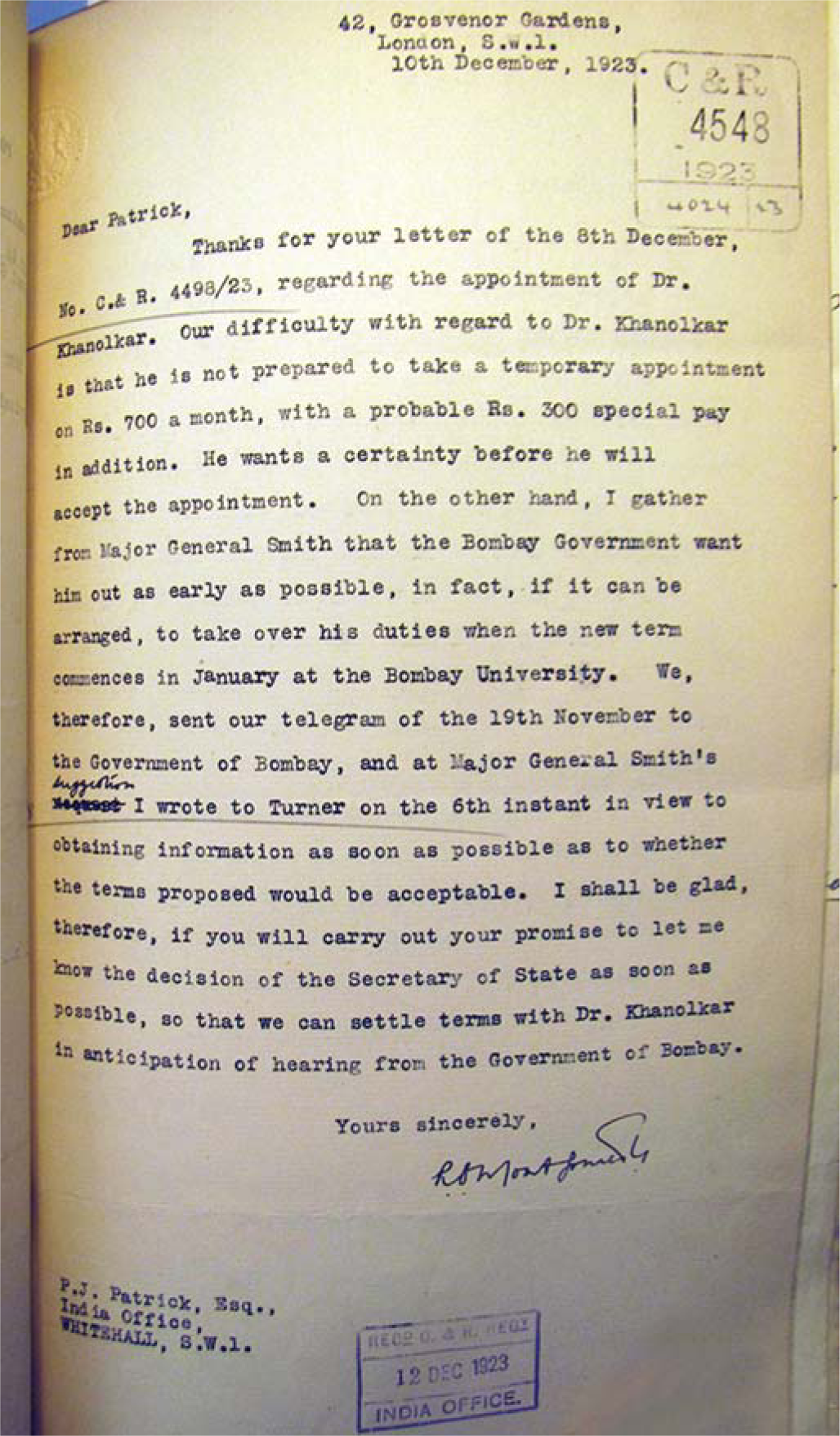
- V.R. Khanolkar’s appointment as Professor of Pathology at Grant Medical College
Two years later, Khanolkar joined KEM Hospital. The college associated with KEM had been established so as to enable Indians to be appointed to important posts that were largely blocked for Indians in other colleges. Khanolkar would have been the perfect choice for this position. But did he only take the job for these reasons? Or was it because the 2-year appointment of his term had come to an end? We do not have access to any records to determine this. It is, of course, possible that documents related to this topic are still available in some archives and will be unearthed by someone in the future. We do know, however, that the salary at KEM was higher.6
We find it fascinating that there seems to have been no formal record of research done by him during the first 17 years of his career in India. Even accounting for the fact that establishing a major department in a new hospital can be time-consuming and fraught with difficulty, this is inconsistent with Khanolkar’s later achievements. After all, he started publishing in the leading journals in less than 4 years after joining TMH.
His student, S.N. Kothare begins the first paragraph of his memoirs,7 ‘At Seth G.S. Medical College, Bombay…we had Dr V.R. Khanolkar, a distinguished pathologist of national and international repute, as the Professor of Pathology and Bacteriology. Because of his eminence he was held in high esteem and we, students, looked at him with awe and inspiration. Whilst lecturing he used to pace the lecture hall from side to side and generally delivered the lecture without facing us. This habit was not conducive to establishing a good rapport with the students inspite of his learned discourses on the subject. His series of lectures on Neoplasia gave us the initial insight into Oncology. He concluded his series on malignant tumours with the statement “Biological behaviour of cancer is unpredictable”,––a statement which later on, I often repeated in my lectures’.
However, Kothare writes (in a letter to the first author of this article, dated 29 January 1995) that ‘these are my personal observations of Dr V.R. Khanolkar, my learned teacher, without prejudice or disrespect’ and also added (oral communication, circa 1999) that ‘the same uninspiring undergraduate teacher was brilliant as a postgraduate teacher’.
A PubMed search for papers by ‘Khanolkar VR’, done on 25 April 2023, listed 1945 as the year of his first research paper. However, we know that this is incorrect because we are aware of at least two papers that he had published, when he was a Graham Research Scholar in London in 1923 and 1924.8,9 One of these papers,8 in fact, was the subject of almost an entire page of commentary in the news section of an issue of Nature.10 Indeed, a book review appearing in the British Medical Journal in 1932 refers to the research as ‘The most illuminating work on the kidney published in recent years’.11 This research was made possible by virtue of the Graham scholarship of £400 a year for two years, beginning 1 April 1921.12 Later, he was awarded £25 from the Thomas Smythe Medical Research Fund for his investigations into non-specific antibodies.13
It is thus possible, that Khanolkar did perform and publish his research during the period 1924 to 1940, but it does not appear on PubMed, or through concerted searches on Google. (It should also be noted that one of Khanolkar’s earliest papers from TMH, and a particularly important one at that, as it deals specifically with the Indian problem of oral cancer,14 is also not on PubMed).
In a tribute to her mentor,15 Kamal Ranadive (scientist and later, Director of the CRI) writes that Khanolkar was born ‘in a small village on the coastal strip of Konkan’, whereas one of us (SAP) has documented Quetta, as his birthplace, based on oral histories that were available to him in 1995. Ranadive also writes ‘He was the moving spirit behind all research activities started at the G.S. Medical College and the hospital in those early years. During his career as Professor of Pathology, he initiated clinical and pathology research at these institutions on the grants procured from IRFA (Indian Research Funds Association), later designated Indian Council of Medical Research…’. Jivraj Mehta (surgeon; physician to Mahatma Gandhi; founder of KEM, and later, first Chief Minister of the newly formed state of Gujarat in independent India)––also reiterates that Khanolkar had received a donation from the Governor’s Hospital Fund, Bombay and ‘constructed a well-planned clinical laboratory with arrangements for experimental studies’ and was ‘extremely keen on developing research facilities at the college and hospital’16 Yet, there seems to be little material available in the departments of pathology in JJ and KEM, about the academic work that he did in these departments.
We are aware of one article (in a journal that was established in Bombay in 1933 but does not exist today and has 38 hits on PubMed, for the years 1945 to 1961 (https://pubmed.ncbi.nlm.nih.gov/?term=med+dig+%5Bso%5D&size=50, accessed 30 September 2023) that Khanolkar published during this period, 1924–1940. The article, published in 1938, when he was in KEM, deals with the subject of anaemia.17 There is an abundance of history of medicine and of quotations in the article. This is also a characteristic of Khanolkar’s subsequent articles.1 In the article, Khanolkar refers to research that had been carried out by him and his students in KEM. He states ‘…anaemia, a subject that has been interesting to us at the King Edward Memorial Hospital in Bombay for the last ten years. We have had an opportunity of studying the condition extensively…’. A table compares the findings of his research with Dr S.H. Gokhale, one of his former assistants, with that of Price-Jones et al. and Sokhey et al. Khanolkar and Gokhale found, on students and nurses at KEM, that the normal red blood cell count was 5.51 per cmm in men and 5.01 per cmm in women. The values of haemoglobin were 15.8 g/dl (men) and 14.26 g/dl (women) while the cell volume per 100 ml was 42.53 and 36.34. He comments that both his data, as well as that of Sokhey’s, shows higher haemoglobin than the corresponding figures in England and finds it ‘difficult to explain’. The exact numbers of subjects are not stated, nor the method of investigation, nor the unit of measurement. The data is, by today’s standards, quite primitive and illustrates the poor state of knowledge about anaemia at that time.
Another table shows the results of a study done by him, Dhayagude and Khadilkar, on patients with ‘true achlorhydria’ (39 cases) and ‘false achlorhydria’ (36 cases) and enumerates the causes for them. He also states that he and Gokhale had an ‘extensive opportunity of studying the blood picture of women in the Antenatal clinic in Nowrojee Wadia Maternity Hospital’. Again, specific numbers of subjects are not mentioned, but we are informed that they discovered that ‘in pregnant women, the red blood cell count is within normal limits up to the second month of pregnancy’, it shows a drop of 500 000 cells/cmm in the third month and then steadily declines until the sixth month and is about 1 250 000 red cells less than normal at that stage. This is normal and if there is a deviation, the anaemia can become severe. Their study also showed that it took more than 7 months for women to regain their normal red cell count.
Finally, the article ends with a table which contains ‘certain figures without much comment, which I hope will increase your perplexity…’. The table contains the figures for the outpatients and inpatients with anaemia, for the years 1927, 1932 and 1937; their average stay in hospital and their clinical follow-up (Fig. 2). Khanolkar succeeds in his quest to perplex us––or at the very least, the three authors of this paper, because we are not quite able to understand what he was trying to get at!
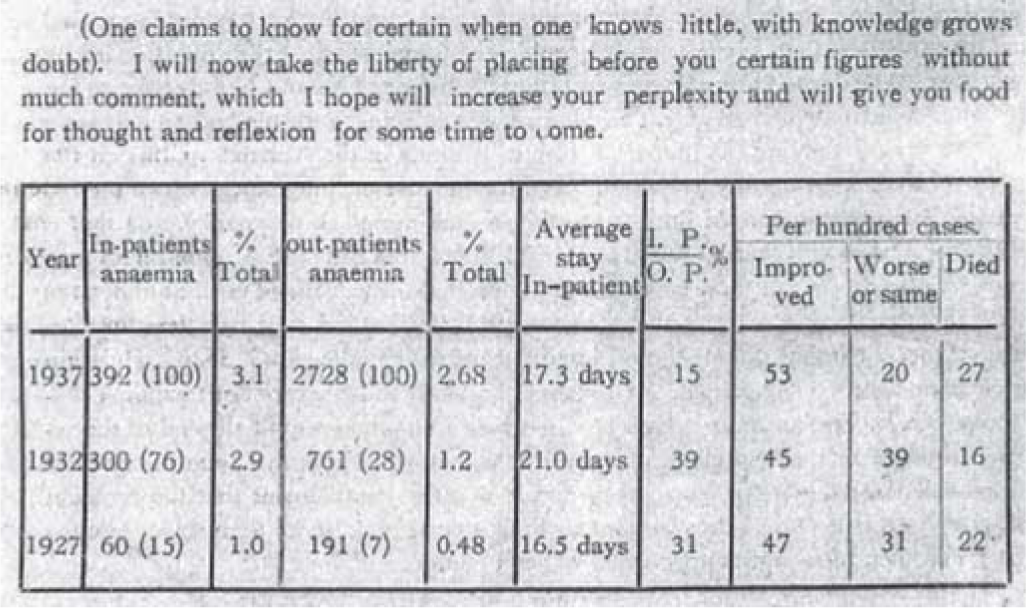
- Concluding table in the paper on anaemia in Medical Digest
We do know that it was during Khanolkar’s period in KEM (1935) he was instrumental in creating the Association of Teaching Pathologists, in which faculty and students from medical colleges in Bombay (hence, ‘teaching pathologists’) convened at a college, by rota, to present their latest research. In 1952, a special issue of Indian Journal of Medical Sciences published the abstracts of the first hundred meetings of the association, i.e. meetings held between 1935 and 1952. The volume was dedicated to Dr Khanolkar.18
At the time the association was formed, there were two medical colleges in the city which participated––Grant Medical College and JJ Hospital (established in 1845); and Seth Gordhandas Sunderdas Medical College and the KEM Hospital (established in 1926). Between 1935 and 1941, only one meeting (the 23rd one on 18 June 1938) was organized by another college, Topiwala National Medical College and the BYL Nair Charitable Hospital, which had been established recently). After 1942, other institutions in the city, such as TMH and Haffkine Institute, also joined the association. The association is a unique organization because it is an informal group and has no organizational posts or positions or any constitution.18 The Association continues to exist even today and currently, more than 10 institutions form the Association.
To determine the kind of research he performed during his pre-TMH days, we retrieved these abstracts and analysed them. There were 39 meetings organized between 13 July 1935 and 1 February 1941. Of these, KEM presented their findings at 20 meetings. (We chose the latter meeting as the last possible meeting that Khanolkar would have been associated with, at KEM, as TMH was inaugurated on 28 February 1941). Khanolkar presented 9 papers of 20 KEM meetings, between the first one (13 July 1935) and the thirty-first (28 July 1939). The topics of these 9 talks (and the dates of the meetings) were:
Demonstration of new staining methods a) Azan b) Saffran c) Orcein (13 July 1935)
Demonstration of a section of mycetoma with a thorn in it (13 July 1935)
Mycotic aneurysm of the aorta (14 September 1935)
Tuberculomata of the interatrial septum with aneurysm of the sinus of Valsalva (14 September 1935)
Mycotic aneurysm (9 November 1935)
Demonstration of different methods of staining nerve (11 July 1936)
Changes in chorio-allantoic membrane in response to certain micro-organisms (3 April 1937)
Bowen’s disease of conjunctiva (19 February 1938)
Dibothriocephalus latus infection (28 July 1939)
As can be seen, the papers presented included topics as varied as staining techniques, anatomic pathology, autopsy pathology and experimental pathology. The first 6 contained only the titles; there were no abstracts or details provided. The last 3 presentations contained abstracts. The seventh presentation was an example of experimental pathology wherein tubercle bacilli, fungi from the Indiella group, and material from lymph nodes from Hodgkin disease were inoculated on the chorio-allantoic membrane; the reaction to these agents was subsequently studied at microscopy.
The abstract on Bowen disease is a case report of ‘a growth situated between the limbus and the outer canthus’ in an ‘elderly person of 70 years’ and which on ‘histologic examination showed atypical cells with hyperchromatic nuclei. Some of these showed atypical mitosis’, while that on Dibothriocephalus latus infection is another case report of ‘faeces showing the operculated ova of Dibothriocephalus latus’ in a patient who ‘had been to Europe for the treatment of his heart attacks, where probably he had caught the infection, the latter being extremely rare in India’.
Only one of these lectures was published by Khanolkar–– that of Bowen disease of the conjunctiva. The May 1946 issue of American Journal of Ophthalmology contains the detailed case history of a 70-year-old physician and elaborates that he ‘had hesitated to report the case fully as my opinion was at variance with that of an eminent English ophthalmologist and the patient was under observation until recently (Fig. 3).19 The paper states that the case had been reported (in part) earlier in Bombay Medical Bulletin in 1938. (Our initial efforts to locate issues of the Bombay Medical Bulletin, or references to it on the internet, were unsuccessful. However, our search for Medical Bulletin had a favourable result. It appears that Khanolkar made an error in the title of the journal!). That this is the same patient is clear because the data mentioned in the report corroborate too.20 The patient had been symptomatic from January 1936 and a lesion had been excised by an ophthalmologist in January 1938 and had been evaluated by Khanolkar. Subsequent recurrences were also examined by Khanolkar. It is fascinating to note that the last such lesion, in April 1939, was reported by Khanolkar as a ‘spindle cell carcinoma of the conjunctiva’––almost two decades before Nathan Lane first reported the concept of the ‘pseudosarcomatous’ variant of squamous cell carcinoma, which comprised spindle and pleomorphic cells.21 The report, however, shows TMH as the authors’ affiliation and makes no mention of the fact that the slides had been evaluated entirely during Khanolkar’s phase at KEM.
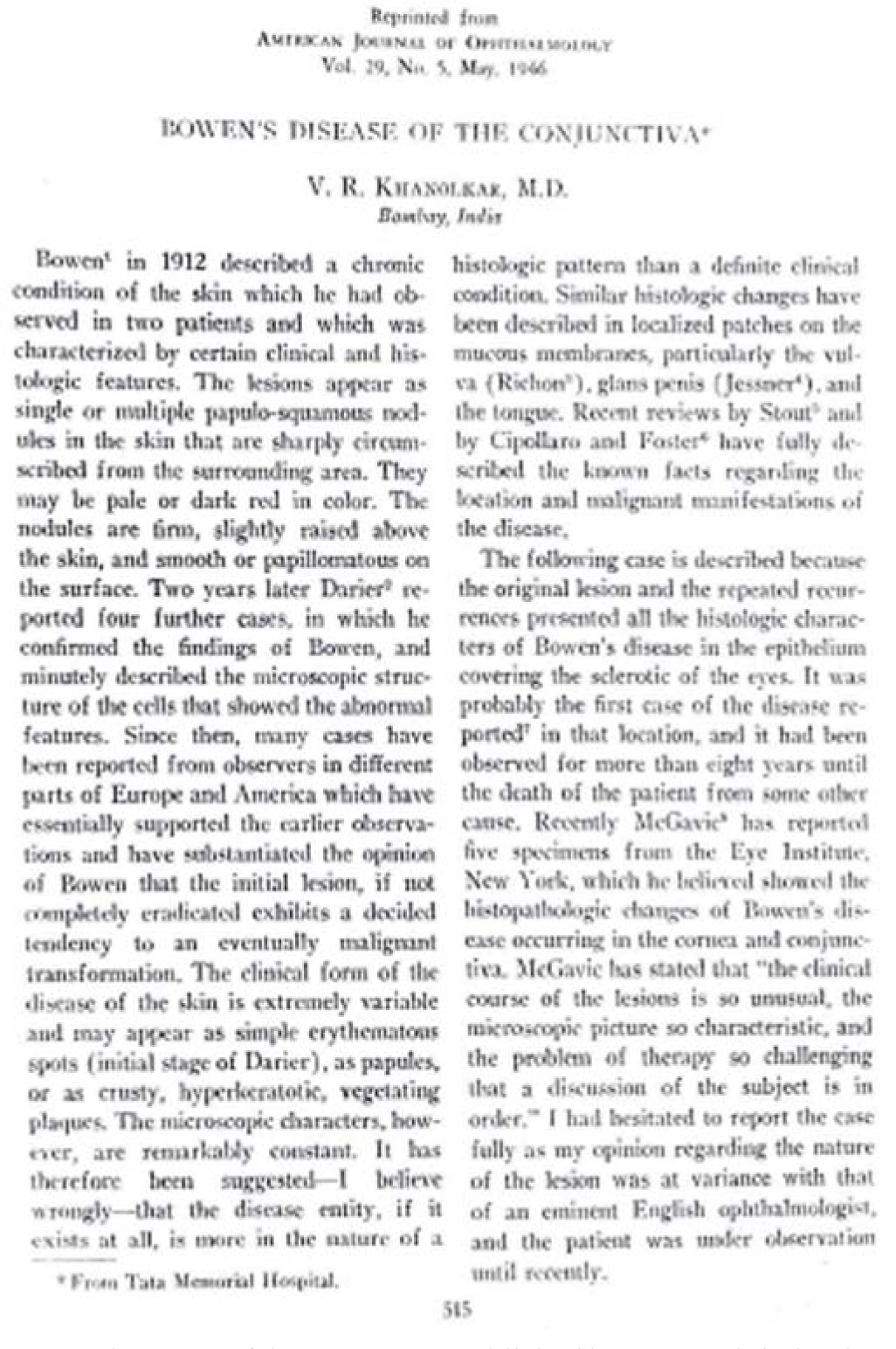
- First page of the case report published in Am J Ophthalmology
It is, of course, likely that Khanolkar would have mentored or overseen most, or all of the other presentations made by his students or junior colleagues. Two of these presentations were published later. Part of the lecture on Rhinosporidiosis by R.G. Dhayagude on 30 October 1937 was published in Indian Medical Gazette22 in September 1941 while that on ‘Non-specific ulcers of the alimentary tract’ by K.D. Manohar (31 August 1940) was published in the same journal in May 1941.23 Khanolkar is not acknowledged in either publication. Does this reflect a particularly advanced example of altruism, where even acknowledgements are not sought? We note that even the two papers that Khanolkar published from the laboratory of A.E. Boycott in London, are single author papers and contain no acknowledgements, or even mention of Professor Boycott!
This practice is of special interest to us given the general habit in India and some other countries, of reflexly appending the name of the head of the department as an author in any paper published from the department. Khanolkar, however, does receive an acknowledgement in the report by Parmanand, on the organism of rat-bite fever in 1929, for ‘giving me an opportunity to work in his Department and also for much kindness and advice.’24
The Presidential Address at the 4th Maharashtra and Karnataka Medical Conference is also available to us. That article deals with Khanolkar’s views on medical education (in which he recommends teaching students in the vernacular languages, rather than in English!) and on public health, indigenous and western medicine, but there is no mention of research in it.25
Finally, while exploring the National Library of Medicine, Bethesda on the internet (https://www.nlm.nih.gov/portals/researchers.html), we had a stroke of luck and discovered a reference to a paper by him on a non-scientific matter: Hindu marriage.26 This paper appears to have been missed by all researchers so far, including in the reminiscences by Kamal Ranadive. However, this paper has been included in the Index Medicus (the forerunner of today’s PubMed) of 1937.27 In this article, Khanolkar makes references to sociology, behavioural science, the Vedas, Manu smriti and Faust! We can speculate that it was this article (the Presidential Address at the Family Hygiene section of the All-India Population Conference, Lucknow, 4 February 1935) that might have resulted in his establishing a Contraceptive Test Unit at the ICRC (which later resulted in the formation of the Institute for Research in Reproduction, and was finally renamed as National Institute for Research in Reproductive and Child Health.
We also wished to extract any possible and potentially useful data from the autopsy registers of the two hospitals. For this, we extracted data from the autopsy registers to record the autopsies performed by Khanolkar during the two years that he was professor at JJ. Further, we looked up the autopsy registers of KEM for the period 1927 to 1940.
Readers may be aware that during a spring cleaning in the department of Pathology at JJ in April 2007, one of us (D.N. Lanjewar) found the previously misplaced autopsy registers for the period 1884 to 1966. The registers were restored professionally and an analysis of the autopsy records from the registers was done, to determine its implications on health, disease and death in Bombay during that period.28 Earlier reports have also made use of this data.29,30
At JJ, Khanolkar performed 23 autopsies between 1924 and 1925: 1 adult in 1924 (of a total of 120 autopsies) and on a 1-year-old girl and 21 adults in 1925 (of 169 autopsies). The ages of 22 adults ranged from 21 to 50 years (21 males, 1 female). The causes of death were mainly infection––pneumonia, tuberculosis, cerebral abscess, cerebral malaria, meningitis and endocarditis. Other causes included aneurysm of the heart, metastatic osteosarcoma and abdominal aneurysm. Thus, the predominant cause of death in these autopsies was infection, as would be expected from the overall data provided by Lanjewar et al.28 Figure 4 shows one of the pages from an autopsy register with some details of an autopsy performed by Khanolkar. This is also the only case in which there is a mention of tissue sections being submitted for histological evaluation. B.B. Dikshit (First Director, All India Institute of Medical Sciences, New Delhi) refers to Khanolkar’s ‘extra-ordinarily bright eyes’ and adds ‘Another extra-ordinary thing he did was that he performed post-mortems himself which according to the practice prevalent in those days were done by a sweeper in the department’.31
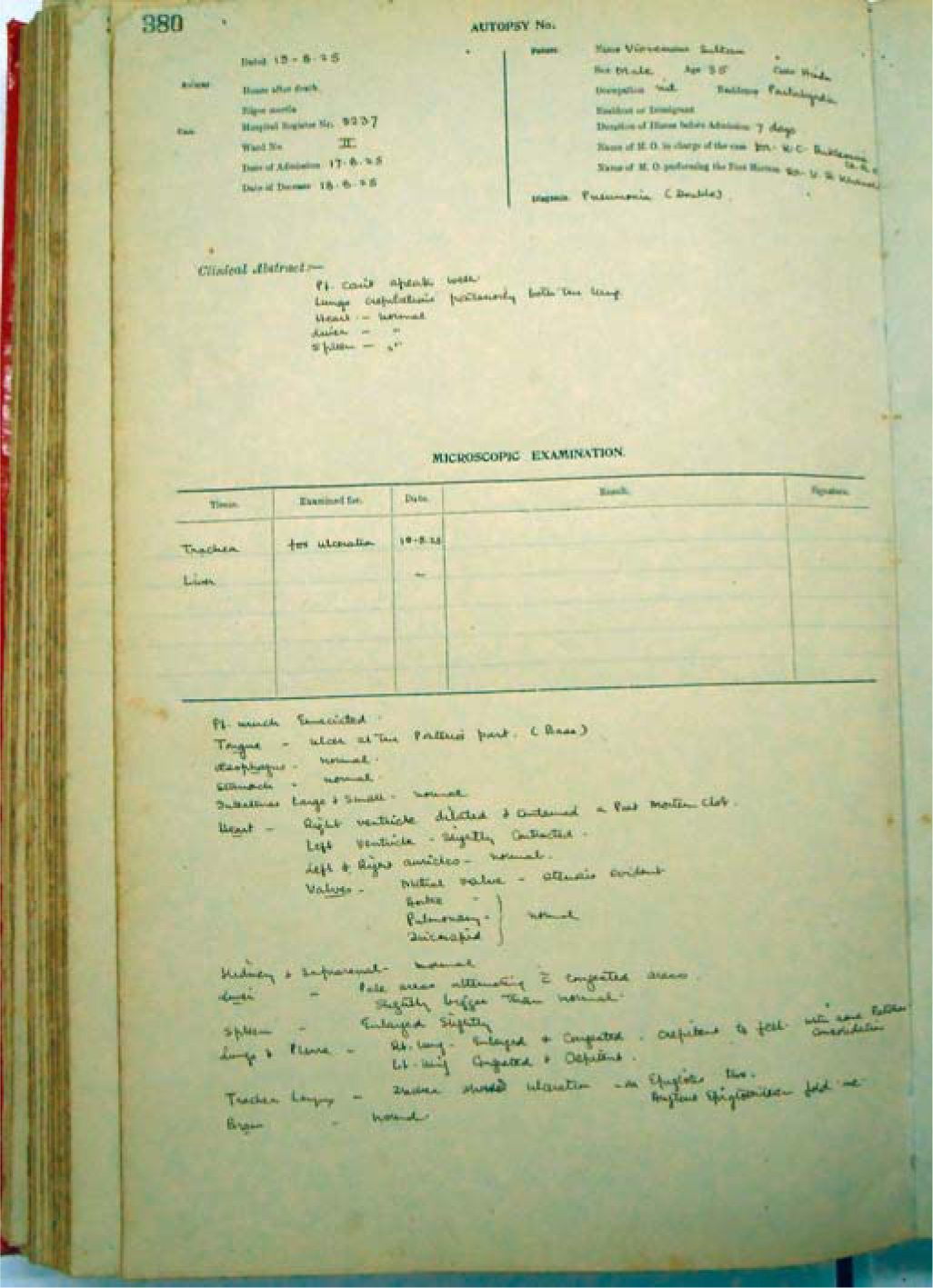
- One of the autopsy register entries for an autopsy performed by V.R. Khanolkar in JJ Hospital
At KEM hospital, it appears that Khanolkar did not perform any autopsies. However, some organs (in 19 cases) were preserved to be shown to him, by other autopsy pathologists, in the year 1934. We do not know why this specific year was chosen. His opinions have not been recorded either. The 19 cases included carcinoma of the ampulla of Vater, gastric carcinoma, cerebral malaria, gangrene of the legs, tubercular peritonitis, head injury, tuberculosis, carotid artery aneurysm, typhoid, cardiac failure, pneumonia, chronic nephritis, septicaemia and acute cholecystitis. Liver, spleen and lung were organs where histological sections were studied in most cases. Figure 5 shows a page of one such autopsy in which reference is made to preserving specimens for Khanolkar’s opinion.
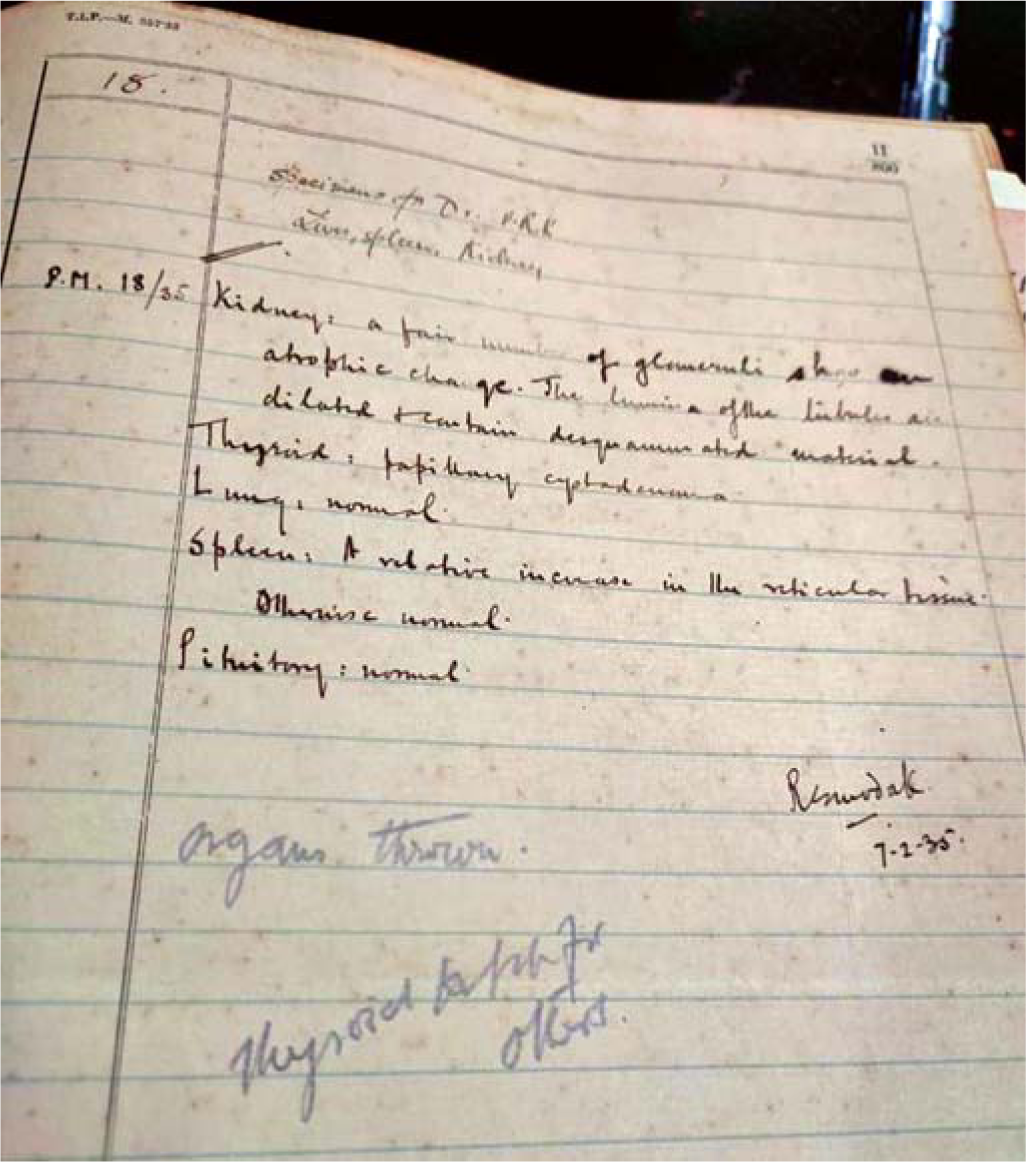
- ‘Specimens for VRK’ is written at the top of the page in this autopsy record from KEM hospital
However, there is one more autopsy, that is particularly striking. We note that on 31 March 1930, the register shows an entry of an autopsy on a 34-year-old woman named Mrs Khanolkar. In the space where the referring physicians name is to be entered, the words ‘Private case, Dr VR Khanolkar’ is written. Given that Khanolkar was a pathologist and would have had no patient admission privileges and given that KEM was a public hospital, we can only speculate that this patient may have been a relative or somebody known to Dr Khanolkar. The cause of death was ‘Addison’s disease (tuberculosis suprarenals)’. The name of the autopsy pathologist is indecipherable (Fig. 6).
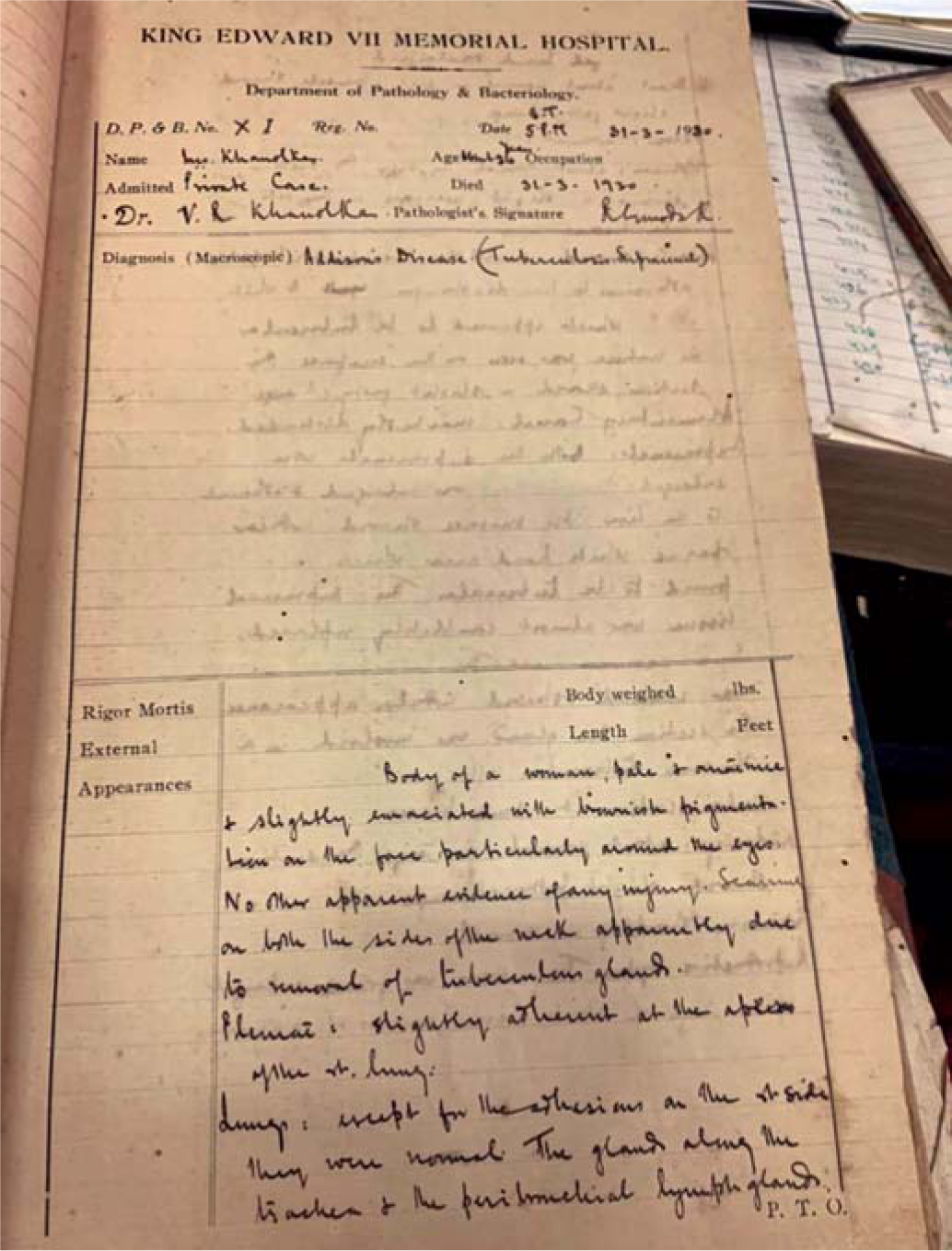
- Autopsy on Mrs Khanolkar: Page from the autopsy register of KEM hospital
There are many questions––all of which may continue to remain unanswered––that arise from this data and analysis of the history of Khanolkar. Why was such little research done by Khanolkar during the period 1924 to early 1941? Was he a ‘late bloomer’? Cancer had just been shown to be a not uncommon problem in Indians32 and thus, when Khanolkar joined TMH, he had a vast uncharted sea to voyage in. Yet, much of medical research was also in its infancy and there were many paths to follow or initiate. Yet, Khanolkar did relatively little by his intellectual standards. Why were the majority of the research presentations at the Association of Teaching Pathologists meetings not published later? Were there financial constraints to research, rather than intellectual constraints? Unfortunately, we do not know. It also appears that we may never know, given that there seem to be no academic or administrative records from 90 years ago maintained in the departments of pathology of these institutions. Unfortunately, records of surgical pathology of the 1920s and 1930s were not traceable at either KEM or at JJ.
Why was histology performed only rarely on the autopsies in 1924 in Grant Medical College? Before 1949, histopathological examination of tissues obtained at autopsy was carried out on unusual lesions and on selected organs––whereas after 1949, histological examination of all organs obtained at autopsy was regularly performed. Given that Khanolkar had recently trained in London, he would surely have been aware of the importance of histology. The eschewing of post-mortem histology could not have been unique to the city of Bombay because the other big teaching hospital, KEM had started histology of autopsies in 1934––with Khanolkar, the doyen of pathology, as the head of the department! Again, was it a question of lack of resources at JJ?
That we were able to procure such limited information is disappointing. In contrast, there have been detailed analyses on the autopsies performed by Sir William Osler.33,34 Admittedly, Osler kept better records and made good use of them. Not only did he perform microscopy in many cases, but he also presented the material at meetings and used it for as many as 160 articles by him and colleagues, between 1872 and 1919. Besides, he also made use of his rich autopsy experience in his famous textbook Principles and Practice of Medicine.
Finally, a delightful, if somewhat peripherally related fact, but which is still relevant in the context of the latter part of this article: the first documented use of the microscope in medicine was in 1700––and it was to confirm findings at autopsy!35 Luca Tozzi was the Professor of Pathology at the Sapienza university, Rome, Italy. He was also the physician to the Pope and performed the autopsy on Pope Innocent XII, who died on 27 September 1700, at the age of 85 years, with the clinical suspicion of colonic cancer. Tozzi used the microscope and described some abnormal glands in the inner layer of the colon. There appeared to be no metastases at autopsy and hence, whether this possible colonic cancer was an incidental finding or the actual cause of death, is not clear. But this much is obvious: histology has for long been known to be crucial for autopsy diagnosis, a fact that keeps being reinforced often.36
To conclude, Khanolkar did not perform much research or publish anything important in the first one and a half decades after his return to India. He conducted some preliminary investigations in the field of anaemia, headed two departments of pathology (which included being the founder of one) and performed autopsies only in the first one.
ACKNOWLEDGEMENTS
Dr Sunil K Pandya, for his comments on an earlier draft of this article and for providing some important references; India Office (The British Library, London), for Figure 1; Many of the relevant references were from the Library, Advanced Centre for Treatment, Research and Education in Cancer (ACTREC), Navi Mumbai; and due to the untiring efforts of Dr Jagdish Sharma, Scientific Officer, Library, Tata Memorial Hospital, Mumbai; Mr Vishal Mali, Senior Technical Officer (1), Library, ICMR-National Institute of Virology (NIV), Pune; Ms Anasua Sen (Librarian, School of Tropical Medicine, Kolkata) and Dr S.K. Guha (Director, School of Tropical Medicine, Kolkata).
References
- V.R. Khanolkar: Father of pathology and medical research in India. Ann Diagn Pathol. 2002;6:334-7.
- [CrossRef] [Google Scholar]
- V.R. Khanolkar. van den Tweel J (eds) Pioneers in pathology Berlin: Springer; 2017. p. :288-90.
- [CrossRef] [Google Scholar]
- Sriramachari. Chintaman Govind (Yeshwant) Pandit, Brig Mem Fell INSA, New Delhi. 2009;35:1-38.
- [Google Scholar]
- Khanolkar and the Indian Cancer Research Centre, 1952-1962. Indian J Cancer. 2019;56:364-7.
- [CrossRef] [Google Scholar]
- Untitled commentary on the impact of V.R. Khanolkar on medicine in India and elsewhere. Natl Med J India. 1996;9:150.
- [Google Scholar]
- 100 years of pathology (in the Grant Medical College) The Antiseptic. 1951;48:397-402.
- [Google Scholar]
- Partial activity of the kidney and the 'all or nothing' principle. J Pathol Bacteriol. 1922;25:414-24.
- [CrossRef] [Google Scholar]
- Non-specific training of antibody production. J Pathol Bacteriol. 1924;27:181-6.
- [CrossRef] [Google Scholar]
- Book review of 'Recent advances in pathology' by Geoffrey Hadfield and Lawrence P. Garrod. BMJ. 1932;2:149-50.
- [Google Scholar]
- Oral cancer in Bombay, India. A report of 1000. consecutive cases. Cancer Res. 1944;4:313-19.
- [Google Scholar]
- Vasant Ramji Khanolkar (1895-1978) 1946. Elected Fellow. Available at www.insaindia.res.in/BM/BM12_8709.pdf (accessed on 25 May 2023)
- [Google Scholar]
- Professor V.R. Khanolkar--An appreciation. In: Professor Khanolkar Felicitation Volume 1963. Bombay: Indian Cancer Research Centre; 1963. p. :2-4.
- [Google Scholar]
- Abstracts of 100 meetings (Association of Teaching Pathologists) Indian J Med Sci. 1952;6:814-65.
- [Google Scholar]
- Pseudosarcoma (polypoid sarcoma-like masses) associated with squamous-cell carcinoma of the mouth, fauces, and larynx; Report of ten cases. Cancer. 1957;10:19-41.
- [CrossRef] [Google Scholar]
- A note on Spirillum minus (Carter), the causative organism of rat-bite fever. Indian Med Gaz. 1929;64:190-1.
- [Google Scholar]
- Presidential address: The 4th Maharashtra and Karnatak Medical Conference, Nasik 1939.
- [Google Scholar]
- Analysis of causes of death as determined at autopsy in a single institute, The Grant Medical College and Sir J.J. Hospital, Mumbai, India, between 1884 and 1966: A retrospective analysis of 13024 autopsies in adults. Arch Pathol Lab Med. 2020;144:644-9.
- [CrossRef] [Google Scholar]
- The incidence of primary carcinoma in India as inferred from postmortem records of 50 years from 1877 to 1926. Indian Med Gaz. 1927;62:315-17.
- [Google Scholar]
- Gharpure's papers (1927-1951) on autopsies at Grant Medical College and Sir J.J. Hospital, Mumbai. Arch Pathol Lab Med. 2020;144:543.
- [CrossRef] [Google Scholar]
- My friend Khanolkar. In: Prof. Khanolkar Felicitation Volume. Bombay: Indian Cancer Research Centre; 1963. p. :13-15.
- [Google Scholar]
- Osler's original autopsy books. Arch Intern Med (Chic). 1949;84:7-11. doi:10.1001/archinte.1949.00230010017003
- [CrossRef] [Google Scholar]
- Osler's autopsies: Their nature and utilization. Med Hist. 1973;17:37-48.
- [CrossRef] [Google Scholar]
- The first recorded use of microscopy in medicine: Pope Innocent XII's autopsy report. Lancet. 2016;388:559.
- [CrossRef] [Google Scholar]




